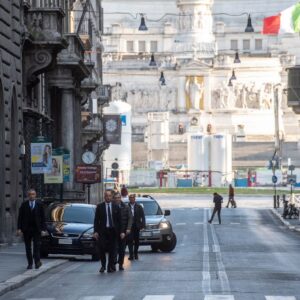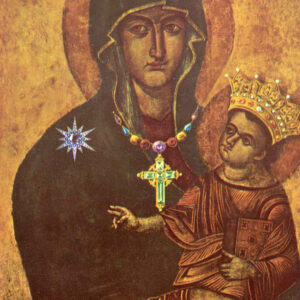Wolfgang Achtner’s article in La Voce di New York, “Corononavirus, Pope Francis: ‘We Thought We’d Stay Healthy in a World that Was Sick’” recounted the very moving, never, ever before (and hopefully never again) somber ceremony at sundown during an ironically appropriate rainstorm on March 27, 2020. Officiated by Pope Francis, almost alone in an eerily empty St. Peter’s Square, the ceremony ended with the papal blessing Urbi et Orbi–to the City and to the World–otherwise only recited on Easter Sunday and Christmas Day.

But then before entering St. Peter’s Basilica to offer communion, a mournful-looking Pope Francis stopped on its steps to pray before two artifacts, moving slowly from one to the other. The first was an icon of the Madonna, known as Salus Populi Romani, and the second, a crucifix. Of all the artifacts in Rome, at first, I wondered why he’d chosen those particular two and I thought that La Voce’s readers might like to know the answer too. I also thought they might like to know where to find them, so that after the pandemic, they too can visit them in situ.
Actually, I immediately recognized the crucifix as the same one Pope Francis had knelt before in the Church of Saint Marcello during his unannounced pilgrimage there on Sunday March 15 to pray for an end to coronavirus. But the icon?

Publicized only after the fact for security reasons was that Pope Francis had walked to the Church of Saint Marcello from the Basilica of St. Mary Major, home to the icon. His special devotion to Our Lady Salus Populi Romani (Salvation of the People of Rome) is well documented. In fact, it wasn’t even the first time he’d slipped out of the Vatican to pray to her. Barely 12 hours after his election (the next morning, even before he’d collected his personal belongings from the House of Hospitality Paul VI), he’d done just that. This first time the new pope had prayed to Our Lady asking for her support on how to guide the Roman Catholic Church into a new age of simplicity and humility.
Since then he has continued to visit this icon on major Marian feast days. He also has made a point to stop in for a prayer both before and after his, as of now, 32 Apostolic trips abroad. The first one was to Rio de Janeiro from July 22-29, 2013 for World Youth Day. He brought with him a of copy of Our Lady’s icon to be carried in procession, a tradition started by Saint John Paul II during World Youth Day celebrated in Rome in 2000.
In her article “Pope’s Love Affair with Mary Hits a New High with 67th Roman Visit”, published in Crux in January 2019, senior correspondent Elise Harris reported that Pope Francis has visited his beloved icon roughly 10 to 15 times a year since his election on March 13, 2013. But since her article was published, you have to add several visits due to several more Apostolic trips in 2019: Panama 23-27 January, United Arab Emirates 3-5 March, Morocco 30-31 March, Bulgaria and North Macedonia 5-7 May, Romania 31 May-June 2, to Mozambique, Madagascar and Mauritius from 4-10 September 2019 and Thailand and Japan from 20-26 November 2019.
According to legend, the icon of Salus Populi Romani (c.46 inches tall by 31 inches wide) was painted by St. Luke himself and brought from Jerusalem to Rome by St. Helena during the 4th century. It’s also said that it was Pope Gregory the Great who brought her icon to St. Mary Major in 590 as part of a procession during Eastertime, praying for an end to one of the deadliest plagues in Rome’s history. Nearly 1,000 years later, another plague in Rome is said to have ended when Pope Pius V, who reigned from 1566-72, carried the Salus in procession to St. Peter’s Basilica. In 1571 the same pope prayed to her for a victory in the Battle of Lepanto.
In 1605 Pope Paul V Borghese commissioned the chapel in St. Mary Major, the icon’s home since 1613, and in 1837 Pope Gregory XVI invoked her to put an end to a cholera epidemic, but after Pius V, the next pope to visit the icon in situ was Pius XII in 1950 after he’d proclaimed the dogma of the Assumption of Mary into heaven. As cardinal he’d celebrated his first Holy Mass with the icon on April 1, 1899. He paid homage to the icon again in 1954 when he crowned her in St. Peter’s Square for the centenary of the dogma of the Immaculate Conception.
In 1931 the icon underwent its first restoration. The principal intervention was the removal of a silver covering of the entire icon except for the faces and head and shoulder of the Madonna and baby Jesus. Gregory XVI had added the silver foil in 1838 to be able to attach two new crowns. Besides his two new crowns, the Madonna’s necklace of three amethysts, four topaz and two aquamarines remained attached, but a new cross was added to it. The missing diamonds of the 12-pointed star were added and the star was attached to the Madonna’s shoulder. (All the icon’s jewels were removed in 1988 and are on display in the Treasury of St. Major Major.)

In 2017 the icon underwent a second and state-of-the-art restoration and conservation in the Vatican Museums. The procedures used included infrared and ultraviolet spectroscopy and reflectography as well as x-rays, pigment studies using Raman and XRF analysis, and radiocarbon dating. These examinations were followed by refilling holes caused by insects; restoration of its golden halo damaged by corrosion; restoration, re-highlighting and repainting various parts of the image; varnishing the back of the image; and strengthening its frame. Morphological studies revealed that the central panels were made of lime wood and the frame of ash. The radiocarbon exams dated the wood, with more than 80% certainty placing it somewhere from the end of the ninth century to the beginning of the eleventh for the central section, and from the end of the tenth and the beginning of the eleventh for the frame. Its historical origins are therefore still shrouded in mystery.

When the icon returned from the Vatican Museums to St. Mary Major, Pope Francis officiated at a Pontifical Mass in her honor on January 28, 2018, the 405th anniversary of her translation to the Basilica. After its 2017-2018 restoration, the Salus Populi Romani has not been allowed to leave St. Mary Major. The icon on the steps on St. Peter’s during Pope Francis’s unique prayer service to end the coronavirus pandemic on March 27th was a copy.
Like the Salus Populi Romani, the crucifix’s origin is not known; it’s probably Tuscan and may date to the fifteenth century. Also like the icon, the Romans are particularly devoted to it. For on the night of May 22, 1519 an earlier church dedicated to San Marcello was almost completely destroyed by fire; only this crucifix remained providentially intact. Then three years later, when a terrible plague raged in Rome, the then Cardinal Titular, to implore divine clemency, promoted a solemn penitential procession. The procession, which lasted 16 days and passed through many Roman neighborhoods, ended at St. Peter’s. Shortly thereafter, the plague ceased.
Epilogue: Let’s hope that, in spite of March 27th’s rain damage to its paint and wood, the crucifix remains “Miraculous” and that Our Lady answers Pope Francis’ prayer so he can go on to his next already planned trips: to Indonesia, East Timor and Papua New Guinea in September of this year, and in 2022 to Portugal, where he already went in 2017, this time for World Youth Day.
Suffice it to say, that the crucifix, after a brief convalescence in the Vatican Museums’ restoration laboratories last week, was back on display, this time inside St. Peter’s, on Palm Sunday and will remain there for all the Easter celebrations. For, as we say in Rome, “La speranza è l’ultima a morire.” So please listen to Dr. Fauci and try to stay well.












